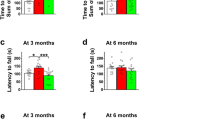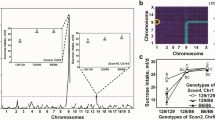Abstract
We examined voluntary NaCl intakes of five mouse strains: NZB/B1NJ, SM/J, 129/J, C57BL/6ByJ, and CBA/J. Using two-bottle tests with water as one choice, the mice were offered series of progressively increasing or progressively decreasing NaCl concentrations (37.5–600 mMNaCl in 48-h tests), then 300 mMNaCl for 6 days and 75 mMNaCl for 8 days. Low concentrations of NaCl were more avidly accepted by mice given the increasing rather than the decreasing series. However, irrespective of the test order, test duration, or how the results were expressed (i.e., as raw intakes, intakes corrected for body weights, or preferences), the NZB/B1NJ mice always had higher NaCl acceptance than did the CBA/J mice. The SM/J, 129/J, and C57BL/6ByJ strains were intermediate between the NZB/B1NJ and the CBA/J strains, but their distributions varied from concentration to concentration. Low (≤150 mM) NaCl concentrations were avoided by the C57BL/6ByJ and CBA/J mice, but the NZB/B1NJ, SM/J and 129/J mice either preferred or were indifferent to them. High (≥300 mM) NaCl concentrations were strongly avoided by all mice, except for the NZB/B1NJ strain. It is suggested that separate genes underlie the strain differences in acceptance of dilute and concentrated NaCl solutions.
Similar content being viewed by others
REFERENCES
Altman, P. L., and Katz, D. D. (1979).Biological Handbooks, III. Inbred and Genetically Defined Strains of Laboratory Animals, Part 1. Mouse and Rat, Federation of American Societies for Experimental Biology, Bethesda, MD.
Bachmanov, A. A. (1993). The genetic analysis of Na and K appetites in hybrids between SHR and WKY rat strains.Appetite 21:162.
Bachmanov, A. A., Tordoff, M. G., and Beauchamp, G. K. (1994). Strain differences in salt appetite in mice.Abstracts of the 2nd Independent Meeting of the SSIB(Hamilton, Canada), A-24.
Bachmanov, A. A., Reed, D. R., Tordoff, M. G., Price, R. A., and Beauchamp, G. K. (1996a). Intake of ethanol, sodium chloride, sucrose, citric acid and quinine hydrochloride solutions by mice: a genetic analysis.Behav. Genet. 26:563–573.
Bachmanov, A. A., Tordoff, M. G., and Beauchamp, G. K. (1996b). Ethanol consumption and taste preferences in C57BL/6ByJ and 129/J mice.Alcohol. Clin. Exp. Res. 20:201–206.
Bachmanov, A. A., Tordoff, M. G., Ninomiya, Y., Inoue, M., Schlager, G., and Beauchamp, G. K. (1997). Genetic differences in NaCl intake in inbred mouse strains: Taste, learning and metabolism.Abstracts of the XXXIII International Congress of Physiological Sciences(St. Petersburg, Russia), P009.03.
Beauchamp, G. K., and Fisher, A. S. (1993). Strain differences in consumption of saline solutions by mice.Physiol. Behav. 54:179–184.
Fujisaki, H. (1983). Genetic and physiological studies of mouse systolic blood pressure.Nippon Seirigaku Zasshi 45:701–710 (in Japanese).
Gannon, K., and Contreras, R. J. (1993). Sodium intake linked to amiloride-sensitive gustatory transduction in C57BL/6J and 129/J mice.Physiol. Behav. 57:231–239.
Hicks, J. D., and Burnet, F. M. (1966). Renal lesions in the “autoimmune” mouse strains NZB and F1 NZB × NZW.J. Path. Bact. 91:467–477.
Hiji, Y., and Sato, M. (1967). Preference-aversion function for sodium monoaminodicarboxylates in rats.J. Physiol. Soc. Japan 29:168–169.
Lush, I. E. (1991). The genetics of bitterness, sweetness, and saltiness in strains of mice. In Wysocki, C. J., and Kare, M. R. (eds.), Chemical Senses, Vol. 3. Genetics of Perception and Communication, Marcel Dekker, New York, pp. 227–241.
Mellors, R. C. (1965). Autoimmune disease in NZB/B1 mice. I. Pathology and pathogenesis of a model system of spontaneous glomerulonephritis.J. Exp. Med. 122:25–40.
Ninomiya, Y., Bachmanov, A. A., Yatabe, A., and Beauchamp, G. K. (in press). NaCl-preferring NZB/B1NY mice and NaCl-avoiding CBA/Y mice have similar amiloride inhibition of chorda tympani responses to NaCl.Chem. Senses.
Ninomiya, Y., Fukami, Y., Yamazaki, K., and Beauchamp, G. K. (1996). Amiloride inhibition of chorda tympani responses to NaCl and its temperature dependency in mice.Brain Res. 708:153–158.
Ninomiya, Y., Sako, N., and Funakoshi, M. (1989). Strain differences in amiloride inhibition of NaCl responses in mice, Mus musculus.J. Comp. Physiol. A 166:1–5.
Sollars, S. I., Midkiff, E. E., and Bernstein, I. L. (1990). Genetic transmission of NaCl aversion in the Fisher-344 rat.Chem. Senses 15:521–527.
Svendsen, U. G. (1977). Spontaneous hypertension and hypertensive vascular disease in the NZB strain of mice.Acta Path. Microbiol. Scand. Sect. A 85:548–554.
Taylor, B. A. (1981). Recombinant Inbred Strains. In Green, M. C. (ed.), Genetic Variants and Strains of the Laboratory Mouse, Gustav Fisher Verlag, Stuttgart-New York, pp. 397–407.
Author information
Authors and Affiliations
Rights and permissions
About this article
Cite this article
Bachmanov, A.A., Tordoff, M.G. & Beauchamp, G.K. Voluntary Sodium Chloride Consumption by Mice: Differences Among Five Inbred Strains. Behav Genet 28, 117–124 (1998). https://doi.org/10.1023/A:1021471924143
Issue Date:
DOI: https://doi.org/10.1023/A:1021471924143




